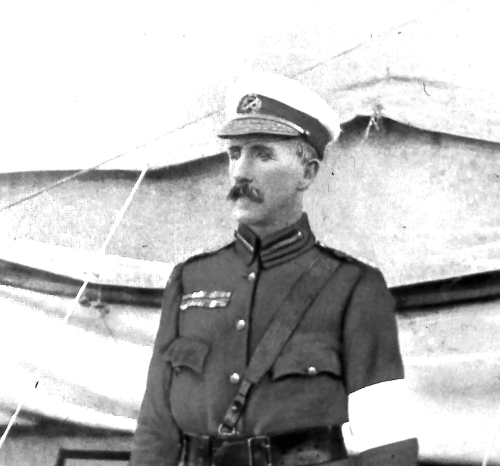Sir William Forbes Gatacre KCB, DSO
Dec 3, 1843 to Jan 18, 1906

William Forbes Gatacre was born at Herbertshire Castle, Stirlingshire, the third son of Edward Lloyd Gatacre and Jessie, daughter of William Forbes of Callendar, Stirlingshire. Educated at the Military College in Sandhurst, William was commissioned as an Ensign in the 77th Foot in India in February, 1862.
In 1873 he passed into the Staff College and from 1875 to 1879, was Instructor of Surveying at the Royal Military College. Returning to India with his regiment in 1880, Gatacre succeeded to command in 1884 at Secunderabad being appointed to DQMG the following year. While holding this post in 1888 he saw his first taste of active service as Chief Staff Officer commanding a small punitive force sent against the tribes of the Black Mountain. His performance in this action earned him considerable attention and rewards and in 1889, he was sent to Mandalay as Brigadier General acting for Sir George Wolseley and there earned another bar for his Frontier Medal. In 1893 he was given the substantive appointment of Adjutant-General, Bombay Army with the rank of Brigadier General and in 1894 was appointed to the command of the Bombay district.
The following year, Gatacre as commander of the 3rd Brigade participated in lifting the siege at Chitral. His last few months in Bombay were marked by a severe outbreak of bubonic plaque. He presided over the commission set up to provide hospitals and to carry out precautionary measures and returned to England in 1897 with the situation well in hand. Gatacre came home to take up the command of and Infantry Brigade at Aldershot but was only there for five months before being sent to Egypt to take command of the British Brigade forming part of Lord Kitcheners Expedition for the recovery of Khartoum. In this engagement Gatacre’s Brigade was raised to a Division and he was given the permanent rank of Major-General. The Battle of Omdurman was fought on September 1, 1898 and Khartoum was occupied the next day.
In October, 1899, Gatacre was sent to South Africa as Commander of the 3rd Division in response to the invasion of Natal and Cape Colony by the Boers. On reaching Cape Town, a new division of troops was made to meet pressure at certain points and Gatacre’s command was reduced to two battalions headquartered at Queenstown. All three divisions suffered defeats at Magersfontein, Colenso and at Stormberg. After the arrival of Lord Roberts in Bloemfontein in March 1900, with large reinforcements, Gatacre’s troops were employed to distribute Peace Proclamations behind the front, line of defence at the express command of the Commander-in-Chief. As a consequence of the unfortunate affair at Sauna’s Post, in which the Boers got possession of the Bloemfontein Waterworks, Gatacre’s peace patrols were exposed to attack. One little group of colonials held on finely at Wepener until relieved; but in the process of withdrawal a small British force, about 190 rifles, was overtaken at Reddersburg, and surrendered an hour before assistance reached them.Gatacre returned to England after this incident but was reinstated to this command of the Eastern district.
In 1905 he joined an expedition to report on the rubber fields of Abyssinia and died of a fever in Gambella on January 18, 1906.
Sir William Gatacre was twice married and had two sons, one of which was killed in action in France in 1914. His wife Beatrix published his life story in 1910.
